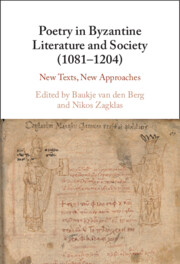Book contents
- Frontmatter
- Dedication
- Contents
- List of Figures
- List of Tables
- List of Contributors
- Introduction: Poetry in Byzantine Literature and Society (1081–1204)
- Part I Poetry and Twelfth-Century Literary Culture
- 1 ‘The Force of Discourses’: Literary Production in the Komnenian Era
- 2 Poetry and Theatre in Twelfth-Century Constantinople
- 3 Rethinking the Mixed Style in Twelfth-Century Poetry
- 4 ‘Wishing to Imitate the Poet’: Prose and the Study of Ancient Poetry in the Twelfth Century
- Part II Poetry and the School
- Part III Poetry, Patronage and Power
- Part IV New Texts, New Interpretations
- Index
3 - Rethinking the Mixed Style in Twelfth-Century Poetry
from Part I - Poetry and Twelfth-Century Literary Culture
Published online by Cambridge University Press: 17 October 2024
- Frontmatter
- Dedication
- Contents
- List of Figures
- List of Tables
- List of Contributors
- Introduction: Poetry in Byzantine Literature and Society (1081–1204)
- Part I Poetry and Twelfth-Century Literary Culture
- 1 ‘The Force of Discourses’: Literary Production in the Komnenian Era
- 2 Poetry and Theatre in Twelfth-Century Constantinople
- 3 Rethinking the Mixed Style in Twelfth-Century Poetry
- 4 ‘Wishing to Imitate the Poet’: Prose and the Study of Ancient Poetry in the Twelfth Century
- Part II Poetry and the School
- Part III Poetry, Patronage and Power
- Part IV New Texts, New Interpretations
- Index
Summary
This chapter delves into the phenomenon of the so-called mixed style, a distinctive feature found in certain literary compositions of the twelfth century. While focusing primarily on the renowned collection of four supplicatory poems known as Ptochoprodromika, it also examines instances of blending lower and higher language registers in the Grottaferrata version of the Digenis Akritis poem and in the Verses from Prison penned by Michael Glykas. The objective of this study is to re-evaluate existing scholarly viewpoints regarding the principles and functions underlying the shifts between language registers in these works, adopting a narratological perspective. In other words, by analysing the employed types of voice, such as direct speech, narration and metanarration, the chapter seeks to determine whether we can identify more specific principles governing the changes in language levels, beyond the general distinction between ‘more popular’ and ‘more learned’. It endeavours to demonstrate that the selection between lower and higher registers is intricately linked to the narrative distance of the speaking voice from the events being recounted.
Keywords
- Type
- Chapter
- Information
- Poetry in Byzantine Literature and Society (1081-1204)New Texts, New Approaches, pp. 95 - 112Publisher: Cambridge University PressPrint publication year: 2024

